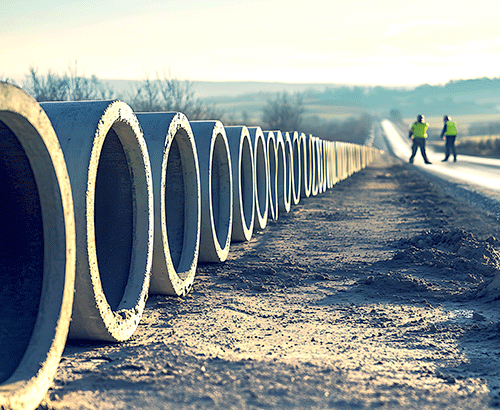The Megaproject Boom: Building the Future Today

Megaprojects, defined as projects costing $1 billion or more, are feats of innovative engineering that catalyze economic growth, technological advancement and sustainability.
FMI forecasts that annual construction put-in-place spending on megaprojects will increase by 30% from 2024 through 2028, representing approximately 10% of total spending for the period.
Whether you directly engage in megaprojects or not, the competitive landscape within which your firm operates has likely changed because of the rise of these monumental undertakings. In an industry ever more enamored with major developments, understanding the megaproject boom and where it’s headed is crucial for professionals in the architecture, engineering and construction (AEC) sector as they position their firms to win work.
Understanding the trends driving these megaprojects, as well as the potential benefits and challenges involved in taking on such projects, can help AEC professionals make informed business decisions about whether to actively seek the opportunities — or to position their firms to succeed elsewhere. (Hint: It’s not just about working on bigger projects. You must transform your firm’s strategy to be successful.)
What are Megaprojects?
At their core, megaprojects are transformative efforts distinguished by their scale, their complexity and the significant coordination they demand. These projects require extensive time and financial commitments, often extending over five years, and are defined by their need for precise, multidisciplinary collaboration.
Megaprojects can occur within any sector but most often fit into one of the following categories.
- Transportation infrastructure: Some examples are iconic bridges, expansive highways, cutting- edge airports, comprehensive mass transit systems and sprawling port complexes that enhance connectivity.
- Energy giants: These include large-scale power generation projects, and both traditional and renewable energy sources and their corresponding transmission networks.
- Urban innovations: These significant urban renewal projects aim to create sustainable, livable spaces for growing populations.
- Manufacturing: Enabling more than the production of simple goods, these buildings are often advanced manufacturing facilities that support national security interests and facilitate technological and energy transitions.
Trends Driving Megaprojects in the U.S.
The societal needs that megaprojects address often persist for years before rising urgency triggers significant government funding alongside private investment. While specific government programs may be temporary, the broader trends they target, such as economic revitalization and technological advancement, are enduring. Megaprojects focused on these issues will likely remain a key part of the U.S. construction industry moving forward.
These trends include:
- Population growth and urbanization. The growth and urbanization of the U.S. population intensify the need for advanced urban infrastructure. The U.S. Census Bureau projects that the national population will reach approximately 345 million by 2030, with urban centers growing faster than rural areas. This will demand enhanced transportation networks, expanded housing supplies and robust public services. Such dynamics emphasize the importance of comprehensive urban planning, with a particular focus on sustainable urban mobility and smart city integrations.
- Aging infrastructure requires ongoing investment. Every four years, the American Society of Civil Engineers (ASCE) evaluates America’s infrastructure, providing a consistent assessment of its condition. In 2017, a grade of D- was issued, which moderately improved to a C- by 2021. These persistently low grades highlight the poor state of the nation’s infrastructure and emphasize the pressing need for substantial rehabilitation and replacement.
This deterioration is a systemic issue that affects roads, bridges and water systems across the country. As such, addressing these challenges requires long-term strategic investment in enhancing the resilience and functionality of essential infrastructure to meet current and future demands.
- Government investment and legislation. Recent government legislation has significantly reshaped the funding landscape for infrastructure and other megaproject initiatives in the U.S. The Infrastructure Investment and Jobs Act (IIJA), Inflation Reduction Act (IRA), and CHIPS and Science Act have collectively sparked unprecedented industry growth.
These acts not only provide immediate financial injections but are also designed to sustain longterm industrial and technological advancements. While each piece of legislation has its own timeline, the foundational objectives they address, such as enhancing infrastructure resilience, promoting energy efficiency and bolstering technological competitiveness, are expected to drive ongoing legislative support. This suggests a probable trend of at least partial reauthorization and the introduction of new, similar legislative measures in the future.
- Advancements in technology fueling larger projects. Technological innovation is a key enabler for larger, more complex projects. The adoption of building information modeling (BIM), artificial intelligence and off-site construction techniques are revolutionizing project efficiency and reducing operational costs. These technological advances facilitate more ambitious projects by improving design precision, construction processes and overall project lifecycle management, allowing the AEC industry to undertake projects of ever-increasing complexity and scale.
- Sustainability and climate initiative prioritization. Concerns over climate change are escalating, driving increased investment toward sustainable and resilient infrastructure. This shift has a twofold impact on the industry. First is the growing imperative to expand large-scale renewable energy projects and the necessary transmission infrastructure to support them. This includes traditional power generation facilities and innovative renewable technologies such as battery storage.
Second, projects not directly related to energy are increasingly designed with climate resiliency in mind. These projects are being adapted to withstand more extreme weather events, flash floods, rising sea levels, prolonged drought conditions and other natural disasters. As a result, adaptations introduce additional scope and complexity to projects, further escalating costs and expanding the scale of infrastructure initiatives.
- Reshoring and strengthening critical industries. The reshoring of critical industries has become a strategic national priority, driven by recent global disruptions and the need for economic security. Significant investments are being directed toward constructing state-of-the-art manufacturing facilities, as seen in the incentives tied to the CHIPS and Science Act. This trend underscores the shift to enhancing national manufacturing capabilities and securing domestic supply chains, influencing the development of these and related infrastructure megaprojects.
Why Understanding Trends is Crucial
Today’s megaprojects will become the benchmark for future industry developments. Professionals aiming to position their firms at the forefront of the shift toward larger projects need to thoroughly understand the underlying trends, so that they’re equipped to navigate the complexities of megaproject procurement and execution and carve out a new trajectory for growth and innovation.
By proactively engaging with these trends, your firm can take strategic action to secure and excel in megaproject initiatives. Specifically, such understanding will help you:
- Assess capabilities. Begin with a thorough assessment of your firm’s existing capabilities to identify how well they meet the demands of current and upcoming megaprojects. This crucial first step helps pinpoint where your expertise aligns with market needs and where it falls short, guiding subsequent actions.
- Enhance and align services. Use the assessment to improve your internal capabilities — addressing identified gaps while keeping aligned with market demands. This involves upgrading skills, adopting new technologies and tailoring your service offerings to meet the needs of megaprojects. Examples: sustainability measures, innovative design and construction methodologies, and advanced project management.
- Forge strategic partnerships. Partnering with other firms can enhance your firm’s capacity to win and manage megaprojects. By collaborating with firms that have complementary expertise or geographic reach, you can tackle a broader scope of project demands, from innovative design to complex project management. These alliances not only enable risks to be shared but also allow for the merging of diverse skills and knowledge, which can lead to more comprehensive solutions and stronger bids for major projects.
- Anticipate market shifts. Diligently track changes in government policies, investment trends, technological innovations and socioeconomic developments, all of which shape the megaproject landscape. By staying informed, your firm can rapidly adapt its strategies to seize emerging opportunities and maintain its competitive advantage.
By taking these actions, you’ll enhance your firm’s internal capabilities and optimize its position in the marketplace, preparing you to compete in an environment in which the scale and complexity of projects continues to grow.
Strategic Advantages of Megaproject Work
Engaging in megaprojects expands your firm’s capabilities and, when marketed well, can position you as a leader in the AEC industry. These projects can provide a platform to showcase innovative solutions and technical prowess, enhance your firm’s reputation and open doors to a host of strategic benefits, setting the stage for further advancements and opportunities.
Enhancing Reputation
Firms can enhance their credibility and prestige within the industry by successfully completing megaprojects — demonstrating the ability to handle large-scale complex projects that demand high levels of expertise, coordination and innovation. This reputation for excellence can position a firm as a thought leader in its field.
Attracting New Clients and Opportunities
Clients such as government agencies, large corporations and international partners typically seek firms with proven experience managing significant projects. By boasting a strong track record in megaprojects, a firm can ramp up its appeal among clients like these, ultimately opening new revenue streams and expanding its market reach. Broadening your firm’s client base not only solidifies its market position — it also fosters long-term partnerships and encourages repeat business.
Leveraging a Diverse and Impressive Portfolio
Showcasing a diverse portfolio that includes megaprojects can serve as a powerful business development tool for firms, differentiating them in project bidding. Potential clients are often drawn to a firm’s extensive experience, confident in its ability to meet the demands of their important ventures.
Driving Internal Growth and Innovation
Engaging in megaprojects often requires firms to adopt the latest technologies and innovative practices, such as advanced BIM, sustainable design principles and integrated project delivery methods. In doing so, a firm enhances its technical capabilities and fosters a culture of continuous learning and improvement among staff.
Establishing Strategic Industry Partnerships
Megaprojects typically involve collaboration with many more stakeholders than traditional projects, including design and construction firms, specialty subconsultants and subcontractors, regulatory bodies and building products companies. Participating in these projects allows a firm to build valuable relationships and networks, which can yield future collaboration opportunities and a stronger position within the industry ecosystem.
Diversifying Risk
By engaging in megaprojects, firms can optimize their project portfolio risk to align with their specific risk appetites. While these projects inherently carry increased risk due to their scale and complexity, they provide a foundation for maximizing revenue over extended periods. By integrating these substantial long-term endeavors with a variety of smaller projects, firms can not only balance their risk exposure but also stabilize and enhance revenue potential. This strategic mix supports financial robustness and growth, enabling firms to thrive across varying market conditions.
The Case for Pursuing Megaprojects
Megaprojects are at the forefront of America’s infrastructure investment resurgence, offering vast opportunities for the AEC industry to drive innovation, sustainability and socioeconomic change. By understanding the trends shaping these projects, your firm can determine how it might fit strategically within an industry segment that is consistently in the spotlight.
Making this determination will enable you to align your capabilities with market demands, seize emerging opportunities and drive growth. From bolstering your firm’s reputation and expanding your market reach to fostering innovation and optimizing risk, the benefits of participating in these monumental projects are substantial. However, undertaking megaprojects also presents unique challenges that require meticulous planning, strategic foresight and robust internal capabilities.
In part 2 of this series, we’ll examine the potential challenges associated with megaprojects and discuss how firms that choose not to undertake them can leverage industry shifts to grow and succeed elsewhere.



